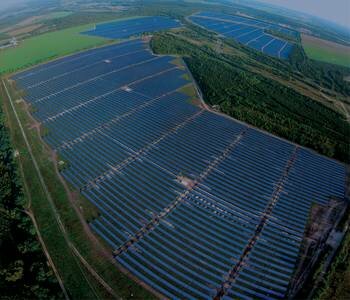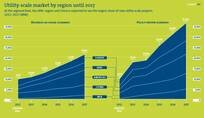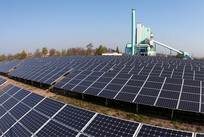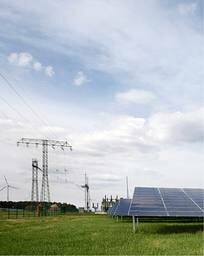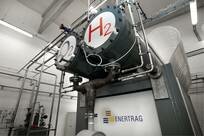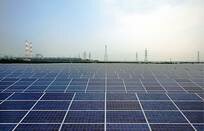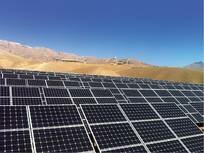So far, there is no recognizable limitation to the maximum power that can be produced. Currently, a 550 megawatt (MW) plant is in the planning stages in California, but even larger plants are quite conceivable.
A power density of 50 MW per square kilometer (km2 ) is not unusual and some manufacturers even indicate an area output of 90 MW per km2 .
Costs are decreasing
Up until a few years ago, the modular price – or more precisely, the price per watt for a turnkey solar power plant – determined the cost of power production. But prices for modules and converters are dropping and the value of property has become an important factor due to the amount of surface area required.
Investment, operating and maintenance costs, as well as property and financing costs are the four most significant components which comprise the levelized cost of energy, or LCOE. They are listed per kilowatt hour (KWh) and take into account the entire cost of power generation in a solar power plant, over the full life cycle of a PV facility.
All over the world, installed system costs are consistently decreasing due to falling component average selling prices.
The installation costs are relatively low; even very large solar power plants can be planned and built in a short period of time. This is how the 148,000 solar modules at the 70-MW Solarpark Meuro in Meuro/Schipkau (Brandenburg, Germany) were installed in only four weeks. The maintenance costs, too, are relatively low, because a PV facility is a fixed installation, and has no moving parts. Therefore, problems may occur almost exclusively in the electrical system. These problems can generally be easily prevented (for example, through professional line layouts) or quickly remedied (for example, by exchanging damaged solar modules or defective converters).
Since sunshine is available everywhere, all that is required is open space and a mains supply point. A large number of solar farms were installed in Germany up until 2012, because they received favorable legislative supply subsidies, and the relatively dense network provides enough nearby mains supply points. This activity reached its peak in 2012 when the number of PV systems with more than 1 MW power accounted PV Power Plants 2014: The industry for a share of about 40 percent of the total market amounting to approximately 7,400 MWp. This corresponds to PV power of about 3,000 MW.
The amount of usable open space for PV was severely reduced due to amendments to the German Renewable Energy Sources Act (EEG). Meanwhile, the largest solar farms in the world have since been built in the USA and China. Open space is available in both of these countries in nearly unlimited quantities, however, a significant upturn began there as soon as system prices had dropped so much in recent years that commercially successful plants were possible even without promotions in the form of supply subsidies.
The utility-scale segment booms in the Americas and Asia including China.
Long-term, predictable investment
Since the sun’s energy is free of charge and relatively consistent and predictable in an average year, despite diurnal and seasonal variables, investment in PV represents long-term, predictable, lucrative investment opportunities with comparatively low risks. The more that fossil energy raw materials prices rise, the greater the advantages for PVs.
When attractive supply subsidies for large solar farms are drastically reduced or even withdrawn, as recently happened in Germany and in Italy, experienced investors begin to explore business models which – depending upon local sun irradiation and regional demand – facilitate commercial operations even without legislated supply subsidies. Solar power is sold through a bilateral agreement (PPA, or Power Purchase Agreement) and preferably to nearby power consumers or utilities. The market for solar power plants continues to develop and increase, following the commercial rules of the power supply market. It is no longer the ratio of subsidies compared to the investment amount, but rather the LCOE that determines whether the investment is considered financially worthwhile.
Since solar modules are mostly oriented directly southwards in order to target maximum yields, they reach their greatest performance levels at mid-day. Therefore, PV competes for the most part with gas-powered plants, which are the predominant producers of peak power. In industrial countries, electricity demands are greatest in the middle of the day; therefore power prices are particularly high at that time.
In Germany and some US regions, the peak power load on some sunny days is nearly completely covered by PV already. The large supply of solar power is causing price drops on the power exchanges. There can even be temporary negative power prices when solar power is abundant due to weather conditions, and conventional power plants are not experiencing regular down-time. That is why solar modules in some new solar facilities are now not being oriented south, but rather east and west. This reduces the mid-day peak of solar power production, and allows more evenly generated power production throughout the day.
Integration into the electricity grid
Solar power production is basically decentralized. The current existing, centralized electricity network must be modified accordingly. In addition, substantial investments are required in some countries to connect remote large-scale solar power plants to the grid.
But PV must also be adjusted to fit the needs of the grid. If solar power plants want to make substantial contributions to electricity generation they must increasingly contribute to the stability of the electricity grid. This certainly is technically possible. Thanks to progress in power electronics, inverters can provide not only active power, but also reactive power. Thus, and through network voltage stabilization, they support relieving the network.
Hybrid power plants and storage
A combination of large solar power plants and nearby wind farms creates hybrid power plants which use a joint mains supply point and are therefore more cost efficient. The entire mains connection power can then be less than the sum of the nominal power for both power plants, since both plants rarely reach nominal power levels at the same time. In such an unusual case, the solar farm, or the wind farm, would be down-regulated for a short period to prevent overloading the supply point.
In countries and regions with weak electricity grids, independent hybrid power plants may make sense. A large PV facility is combined with a diesel generator. Then the use of solar energy to produce electricity can directly lead to savings in expensive fuel. When the hybrid power plant is supported by the use of batteries, the solar facility can further reduce the operating hours for the diesel generator.
The first solar power plants can be combined with battery storage in order to increase the availability of solar power. This means that electricity not only sells during the middle of the day when it is inexpensive, but also at other times of the day. Battery storage can overcome stronger load jumps better than conventional power plants can, and therefore basically improves mains support and control.
Future markets
In Germany, the boom in outdoor facilities ended in 2013, as the federal government drastically reduced energy supply subsidies and imposed strict limitations on the available space to be used for solar farms, while facilities producing more than 10 MW received no more subsidies at all.
At the same time, demand has been increasing in Asia and the USA, although the governmental stimuli were considerably lower, or absent altogether. Solar power plants in the USA are frequently financed by PPAs. Solar power is sold to the regional network operator or a large electricity consumer at a fixed price, sometimes with a price increase which corresponds to the inflation rate.
In 2013, Asia took over the lead after 10 years of continuous European leadership in new installations.
In China and India, the governments and large energy consumers are offering new projects which will be determined through a bidding process. A stable PV market has been established in Thailand in this way. PV is the only renewable energy in Japan which can be developed in a short period of time; it is also one of the few alternatives to nuclear energy. Therefore, strong growth patterns can be expected in the solar market in Japan.
The MENA region (Middle East & North Africa) offers good development opportunities for PV applications thanks to strong sun irradition – at least in those countries that have sufficient financial means due to copious income from petroleum and natural gas.
PV competes ever-more strongly with decentralized diesel power plants. In areas where power grids exist but are unreliable, PV power plants may operate in parallel and then bridge periods when the power fails. Increasing fuel prices also create an economic movement in favor of the continued development of PV plants – even without statutory supply subsidies.

